
The blacklegged tick is a species of biting arachnid that is commonly referred to as a deer tick because they primarily feed on the blood of white-tailed deer. While they prefer to feed on deer they will also feed on other large animals, livestock, amphibians, and humans. They are primarily found in the northeastern, mid-Atlantic, southeastern and north central parts of the U.S. They are an important pest to control because they can spread Lyme disease to humans and other animals.
| Pest Identification | |
|---|---|
| Recognition | The adult blacklegged tick has an oval broad shaped body and is brownish-orange in color. They have darker colored legs compared to the rest of their body. After feeding they will become a rusty brown color and increase in size as their body engorges with blood. Before feeding adult ticks are about the size of a sesame seed or about 1/8th of an inch in length. Males are smaller (1/16″) in size than the females. |
| Biology | The life cycle of the blacklegged deer tick is dependent on environmental conditions and how many hosts are available for them to feed on. The entire process generally takes 1-2 years, but can take up to 4 years. In the spring a female deer tick will lay a very large number of eggs (up to 3,000) in the vegetation. After laying her eggs the female will die. A six-legged larva emerges from the egg and then chooses a small animal like a mouse or other rodent to feed on. After feeding for a period of time it drops off of the host and molts into an 8 legged nymph. The nymph then chooses another host to feed on until they are ready to drop off and molt into an adult. After becoming an adult the blacklegged deer tick chooses a third host to feed from. This host can include white-tailed deer, raccoons, foxes, squirrels, chipmunks, farm animals, and humans. Blacklegged deer ticks carry and transmit Lyme disease. This serious disease can become quite debilitating overtime if treatment is not sought. The first symptoms of Lyme disease can mimic those of the flu. Symptoms like fever, aches, and pain. The person bit more often than not develop a distinctive bulls-eye rash in one area or several areas of their body. Overtime untreated Lyme disease will lead to complications with the heart and nervous system, along with joint swelling and the erosion of cartilage and bone. Lyme disease is caused by the corkscrew shaped bacterium Borrelia burgdorferi. An infected tick can easily transmit this disease to each host that it feeds on, and thus quickly spreading the disease throughout an area. The longer the tick is attached to and feeds on the host the greater the chance that they will become infected with the Lyme disease pathogen. If a tick is found and effectively removed from a host within 24 hours it will greatly reduce the chances on contracting Lyme disease. If you find a tick attached to your or your pet you should use a pair of fine tipped tweezers, not your fingers, to grasp the tick as close to the skin of the host as possible and pull it off. You can save the tick in rubbing alcohol to bring to your doctor for identification. |
| Habits | Blacklegged deer ticks cannot fly or jump, instead they hide out in areas of thick vegetation waiting for a suitable host to come by and brush up against them. They then climb onto and up a host to find a suitable place to feed from. They grasp the skin of the host, bite painlessly through the skin, insert a feeding tube, and begin to feed slowly for several days before becoming engorged and dropping off. Blacklegged deer ticks need a humid environment to survive and this is why they are generally found hiding in dense vegetation, high grasses, wooded areas, along fence lines, and along wooded footpaths. |
| Prevention | Controlling the spread of ticks can be a difficult task, but can be achieved by altering the environment to make it less appealing to them and their hosts, by protecting yourself from ticks, and by implementing a professional tick control program. Environmental control- -Keep grass that is located on your property cut very low, especially around fences, sheds, garages, and trees. -Remove piles of leaves, sticks, and other organic debris that ticks can hide and live in. -Keep hosts away from your property by making sure garbage cans have tight fitting lids on them, by not feeding birds, and by making necessary changes around your home (install chimney caps, attic vent screens) in order to prevent rodents and wild animals from being able to enter inside of it. Personal Protection- -Use insect repellants when spending time outside, especially in wooded areas. -Wear light colored long sleeves and light colored long pants that are tucked into your boots or socks while outside. -Check yourself, children and pets before coming inside from outdoors. -Treat your pets under the guidance of a veterinarian with tick preventative. |
| Professional | A Rottler technician will inspect your property and treat the exterior perimeter of the structure or the entire property with an appropriately labeled residual pesticide if ticks are present. Rottler technicians may also perform an exterior perimeter rodent control program to reduce the host populations for ticks. |

